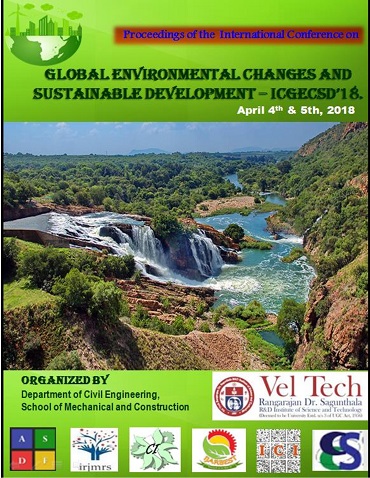- Publication Meta:Value
- Short Title:ICGECSD 2018
- Publisher:ASDF, India
- ISBN 13:978-81-933584-6-7
- ISBN 10:81-933584-6-5
- Language:English
- Type:Hard Bound - Printed Book
- Copyrights:ICGECSD Organizers / [email protected]
- Editor-in-Chief:Dr E B Perumal Pillai
- Conference Dates:04 - 05, April 2018
- Venue Country:Veltech R&D Institute of Science and Technology, Chennai, India
- Submitted Papers:230
- Acceptance Rate:8.12%
- Website:www.veltech.edu.in/icgecsd
Welcome to ASDF Electronic Digital Library!
ICGECSD 2018
ICGECSD 2018
International Conference on Global Environmental Changes and Sustainable Development 2018
Paper 081
Removal of Copper from Electroplating Industry Water Using Dead Saccharomyces Cerevisiae
Dr D Sivakumar1, M Mahalakshmi2, T M Modhini3
1Professor, 2,3Final Year Student, Department of Civil Engineering,
Vel Tech Rangarajan Dr.Sakunthala R & D Insititute of Science & Technology, Avadi, Chennai, India
Abstract
The present study focused to reduce Cu (II) ions from electroplating industry wastewater of Ambattur Industrial Estate, Chennai using dead Saccharomyces cerevisiae. The experiments were conducted against the effect of different pH, biomass, agitation speed and dilution ratio to know the effectiveness of dead Saccharomyces cerevisiae for removing Cu (II) ions from electroplating industry wastewater. The results showed that the maximum removal of Cu (II) by Saccharomyces cerevisiae at an optimum pH of 6, an optimum biomass of 4 g, agitation speed of 150 rpm and an optimum dilution ratio of 3 was found to be 98.3% with the contact time of 80 min. Also, the study focused on validating the removal of Cu (II) ions from electroplating industry wastewaterthe other parameters present in the electroplating industry wastewater using the same Saccharomyces cerevisiae. The validation results showed that maximum removal of total dissolved solids (TDS), total solids (TS), chemical oxygen demand (COD), biochemical oxygen demand (BOD), and sulphate (SO42-) by Saccharomyces cerevisiae species was found to be 92.1%, 94.7%, 96.7%, 97.2% & 95.3% respectively and Cu (II) in aqueous solution is about 99.2% at the same optimum pH of 6, an optimum biomass of 4 g, agitation speed of 150rpm and an optimum dilution ratio of 3 against contact time of 80minutes. From the kinetic model, it was found that Intra particle diffusion kinetic model was best fitted with the experimental data with the R2 value of 0.98 and from the Isotherm model, it was found that Freundlich Isotherm model was best fitted with the experimental data with the R2 value of 0.999. Thus, this study was concluded that the Saccharomyces cerevisiae species might be used as sorbents for removing not only Cu (II) ion in a electroplating industry wastewater but also remove any other contaminants in a electroplating industry wastewater.
Keywords
Author's Profile
Author profile can be generated and linked through our partners World Book of Researchers. To include your profile online Click Here. After it is approved, please email to edlib @ asdf.res.in to create a link with all the papers.
e-AID
ICGECSD.2018.081
Cite this Article as Follows
Dr D Sivakumar, M Mahalakshmi, T M Modhini. Removal of Copper from Electroplating Industry Water Using Dead Saccharomyces Cerevisiae. International Conference on Global Environmental Changes and Sustainable Development (2018): 81. Print.
© 2010 - by EDLIB .
All Rights Reserved.

